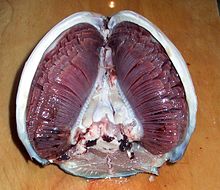Aquatic respiration

Aquatic respiration is the process whereby an aquatic organism exchanges respiratory gases with water, obtaining oxygen from oxygen dissolved in water and excreting carbon dioxide and some other metabolic waste products into the water.
Unicellular and simple small organisms
In very small animals, plants and bacteria, simple diffusion of gaseous metabolites is sufficient for respiratory function and no special adaptations are found to aid respiration. Passive diffusion or
Higher plants
Although higher plants typically use carbon dioxide and excrete oxygen during photosynthesis, they also respire and, particularly during darkness, many plants excrete carbon dioxide and require oxygen to maintain normal functions. In fully submerged aquatic higher plants specialised structures such as stoma on leaf surfaces to control gas interchange. In many species, these structures can be controlled to be open or closed depending on environmental conditions. In conditions of high light intensity and relatively high carbonate ion concentrations, oxygen may be produced in sufficient quantities to form gaseous bubbles on the surface of leaves and may produce oxygen super-saturation in the surrounding water body.
Animals
All animals that practice truly aquatic respiration are
Echinoderms
Echinoderms have a specialised water vascular system which provides a number of functions including providing the hydraulic power for tube feet but also serves to convey oxygenated sea water into the body and carry waste water out again. In many genera, the water enters through a madreporite, a sieve like structure on the upper surface but may also enter via ciliary action in the tube feet or via special cribiform organelles.[1]
Molluscs
Arthropods
Aquatic
Fish
Most fish exchange gases using gills on either side of the pharynx (throat), forming the splanchnocranium, the portion of the skeleton where the cartilage of the cranium converges into the cartilage of the pharynx and its associated parts.[3] Gills are tissues which consist of threadlike structures called filaments. These filaments have many functions and are involved in ion and water transfer as well as oxygen, carbon dioxide, acid and ammonia exchange.[4] Each filament contains a capillary network that provides a large surface area for the exchange of gases and ions. Fish exchange gases by pulling oxygen-rich water through their mouths and pumping it over their gills. In species like the spiny dogfish and other sharks and rays, a spiracle exists near the top of the head that pumps water into the gills when the animal is not in motion.[5] In some fish, capillary blood flows in the opposite direction to the water, causing countercurrent exchange. The muscles on the sides of the pharynx push the oxygen-depleted water out the gill openings. In bony fish, the pumping of oxygen-poor water is aided by a bone that surrounds the gills called the operculum.[6]
Amphibians
Both the lungs and the skin serve as respiratory organs in amphibians. The skin of these animals is highly vascularized and moist, with moisture maintained via secretion of mucus from specialized cells. While the lungs are of primary importance to breathing control, the unique properties of cutaneous respiration supplements rapid gas exchange when amphibians are submerged in oxygen-rich water.[7]
Aquatic reptiles, birds and mammals
All aquatic
The
Gills

Many aquatic animals have developed gills for respiration which are specifically adapted to their function. In fish, for example, they have:
- A large surface area to allow as much oxygen to enter the gills as possible because more of the gas comes into contact with the membrane
- Good blood supplyto maintain the concentration gradient needed
- Thin membrane to allow for a short diffusion pathway
- Each gill arch has two rows (hemibranchs) of gill filaments
- Each gill filament has many lamellae
In
Bony fish use countercurrent flow to maximize the intake of oxygen that can
Control of respiration
In fish
The respiratory rhythm is modulated to adapt to the oxygen consumption of the body. As observed in mammals, fish “breathe” faster and heavier when they do physical exercise. The mechanisms by which these changes occur have been subject to debate .[14] The views can be classified as either that the major part of the respiratory changes are pre-programmed in the brain, which would imply that neurons from locomotion centers of the brain connect to respiratory centers in anticipation of movements, or that the major part of the respiratory changes result from the detection of muscle contraction, and that respiration is adapted as a consequence of muscular contraction and oxygen consumption. The latter view would imply that the brain possesses some kind of detection mechanisms that would trigger a respiratory response when muscular contraction occurs.
Many now agree that both mechanisms are probably present and complementary, or working alongside a mechanism that can detect changes in oxygen and/or carbon dioxide blood saturation.
See also
- Anaerobic respiration
- Cellular respiration
- Control of respiration
- Ecosystem respiration
- Maintenance respiration
- Respiratory system
Notes
- ^ Nichols, Davd (1967). Echinodermms (third ed.). Hutchinson University Library. p. 44.
- ^ "Getting Oxygen" (PDF). British Ecological Society. united kingdom. April 2016.
- ^ "Introduction to the skeletal system". www.shsu.edu. Retrieved 2019-06-07.
- PMID 21423356.
- ISBN 0-7167-0691-1.)
{{cite book}}: CS1 maint: location missing publisher (link - S2CID 53466588.
- PMID 4976.
- ^ "reptile - animal". Retrieved 8 September 2016.
- ISBN 978-0-486-69191-6.
- ISBN 978-3-540-25595-6.
- ^ ISBN 978-3-89993-049-8.
- ISBN 978-0-12-747605-6.
- S2CID 19436421.
- PMID 16467394.


